Managing and Running a Small Business: Resource Planning, CRM, Finance
VerifiedAdded on 2023/01/09
|21
|4169
|53
Report
AI Summary
This report delves into the core aspects of managing and running a small business, offering a comprehensive analysis of resource allocation, planning, and financial management. It examines the critical considerations in resource allocation, including human resources, financial resources, and organizational goals. The report explores various tools and techniques, such as Gantt charts and critical path analysis, used for effective planning and resource assignment. Furthermore, it discusses the importance of planning and resource allocation in achieving organizational objectives, along with CRM processes for managing small entities. The report also covers financial statements, including break-even analysis and cash flow forecasts, and their role in successful business management. Finally, it addresses relevant legislation impacting small businesses and the potential for transnational business expansion, including its benefits and limitations. This report provides valuable insights into the multifaceted challenges and opportunities faced by small businesses.

MANAGING AND
RUNNING A SMALL
BUSINESS
RUNNING A SMALL
BUSINESS
Paraphrase This Document
Need a fresh take? Get an instant paraphrase of this document with our AI Paraphraser
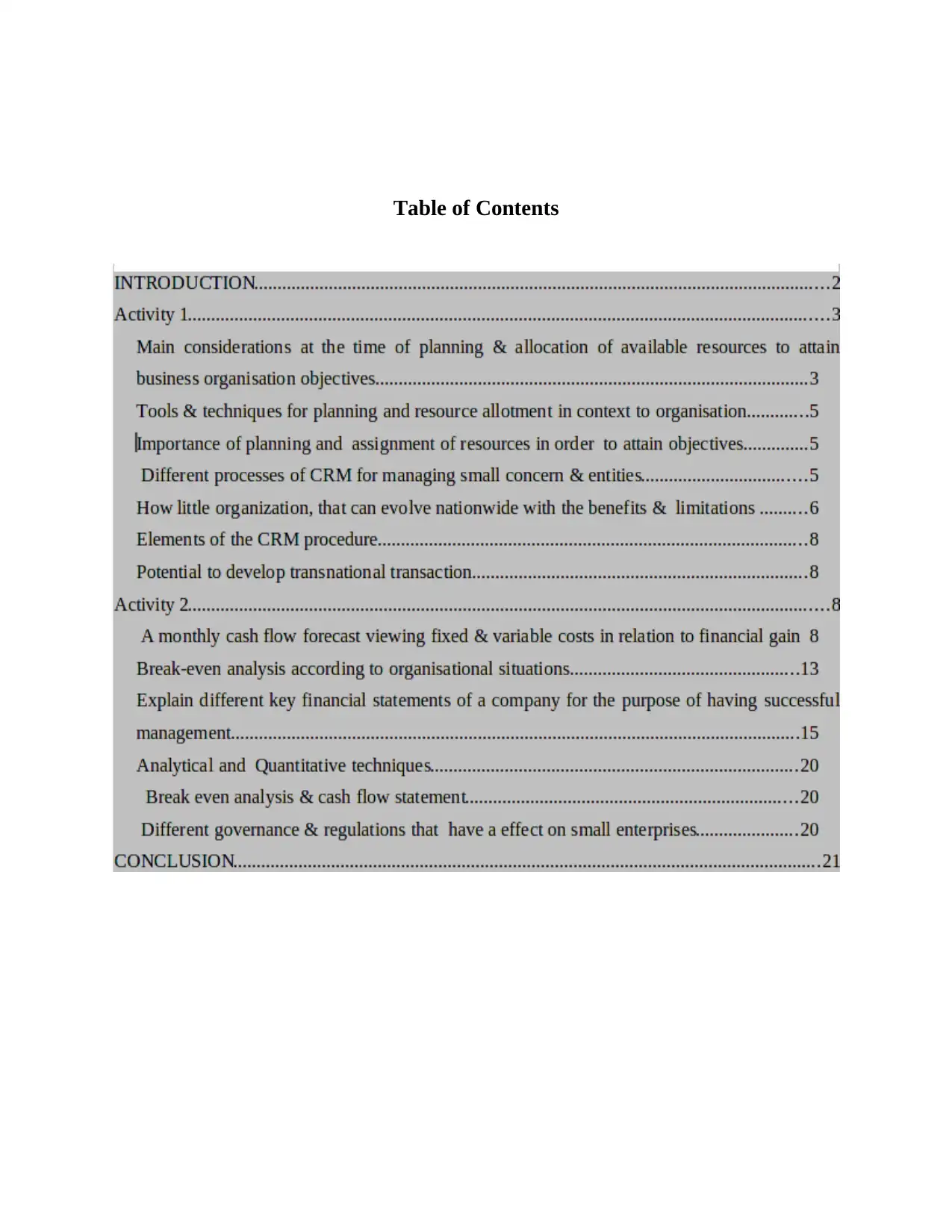
Table of Contents

⊘ This is a preview!⊘
Do you want full access?
Subscribe today to unlock all pages.

Trusted by 1+ million students worldwide
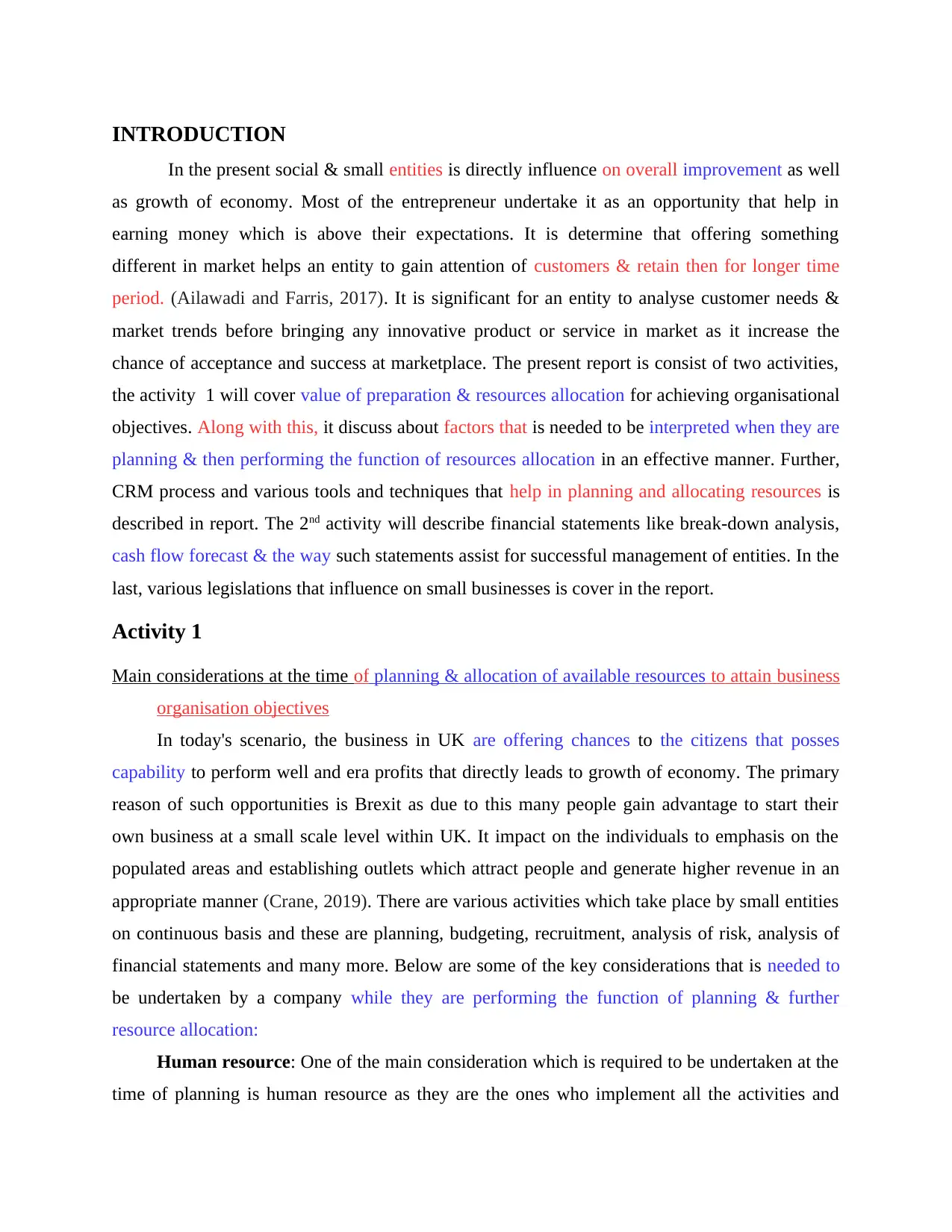
INTRODUCTION
In the present social & small entities is directly influence on overall improvement as well
as growth of economy. Most of the entrepreneur undertake it as an opportunity that help in
earning money which is above their expectations. It is determine that offering something
different in market helps an entity to gain attention of customers & retain then for longer time
period. (Ailawadi and Farris, 2017). It is significant for an entity to analyse customer needs &
market trends before bringing any innovative product or service in market as it increase the
chance of acceptance and success at marketplace. The present report is consist of two activities,
the activity 1 will cover value of preparation & resources allocation for achieving organisational
objectives. Along with this, it discuss about factors that is needed to be interpreted when they are
planning & then performing the function of resources allocation in an effective manner. Further,
CRM process and various tools and techniques that help in planning and allocating resources is
described in report. The 2nd activity will describe financial statements like break-down analysis,
cash flow forecast & the way such statements assist for successful management of entities. In the
last, various legislations that influence on small businesses is cover in the report.
Activity 1
Main considerations at the time of planning & allocation of available resources to attain business
organisation objectives
In today's scenario, the business in UK are offering chances to the citizens that posses
capability to perform well and era profits that directly leads to growth of economy. The primary
reason of such opportunities is Brexit as due to this many people gain advantage to start their
own business at a small scale level within UK. It impact on the individuals to emphasis on the
populated areas and establishing outlets which attract people and generate higher revenue in an
appropriate manner (Crane, 2019). There are various activities which take place by small entities
on continuous basis and these are planning, budgeting, recruitment, analysis of risk, analysis of
financial statements and many more. Below are some of the key considerations that is needed to
be undertaken by a company while they are performing the function of planning & further
resource allocation:
Human resource: One of the main consideration which is required to be undertaken at the
time of planning is human resource as they are the ones who implement all the activities and
In the present social & small entities is directly influence on overall improvement as well
as growth of economy. Most of the entrepreneur undertake it as an opportunity that help in
earning money which is above their expectations. It is determine that offering something
different in market helps an entity to gain attention of customers & retain then for longer time
period. (Ailawadi and Farris, 2017). It is significant for an entity to analyse customer needs &
market trends before bringing any innovative product or service in market as it increase the
chance of acceptance and success at marketplace. The present report is consist of two activities,
the activity 1 will cover value of preparation & resources allocation for achieving organisational
objectives. Along with this, it discuss about factors that is needed to be interpreted when they are
planning & then performing the function of resources allocation in an effective manner. Further,
CRM process and various tools and techniques that help in planning and allocating resources is
described in report. The 2nd activity will describe financial statements like break-down analysis,
cash flow forecast & the way such statements assist for successful management of entities. In the
last, various legislations that influence on small businesses is cover in the report.
Activity 1
Main considerations at the time of planning & allocation of available resources to attain business
organisation objectives
In today's scenario, the business in UK are offering chances to the citizens that posses
capability to perform well and era profits that directly leads to growth of economy. The primary
reason of such opportunities is Brexit as due to this many people gain advantage to start their
own business at a small scale level within UK. It impact on the individuals to emphasis on the
populated areas and establishing outlets which attract people and generate higher revenue in an
appropriate manner (Crane, 2019). There are various activities which take place by small entities
on continuous basis and these are planning, budgeting, recruitment, analysis of risk, analysis of
financial statements and many more. Below are some of the key considerations that is needed to
be undertaken by a company while they are performing the function of planning & further
resource allocation:
Human resource: One of the main consideration which is required to be undertaken at the
time of planning is human resource as they are the ones who implement all the activities and
Paraphrase This Document
Need a fresh take? Get an instant paraphrase of this document with our AI Paraphraser
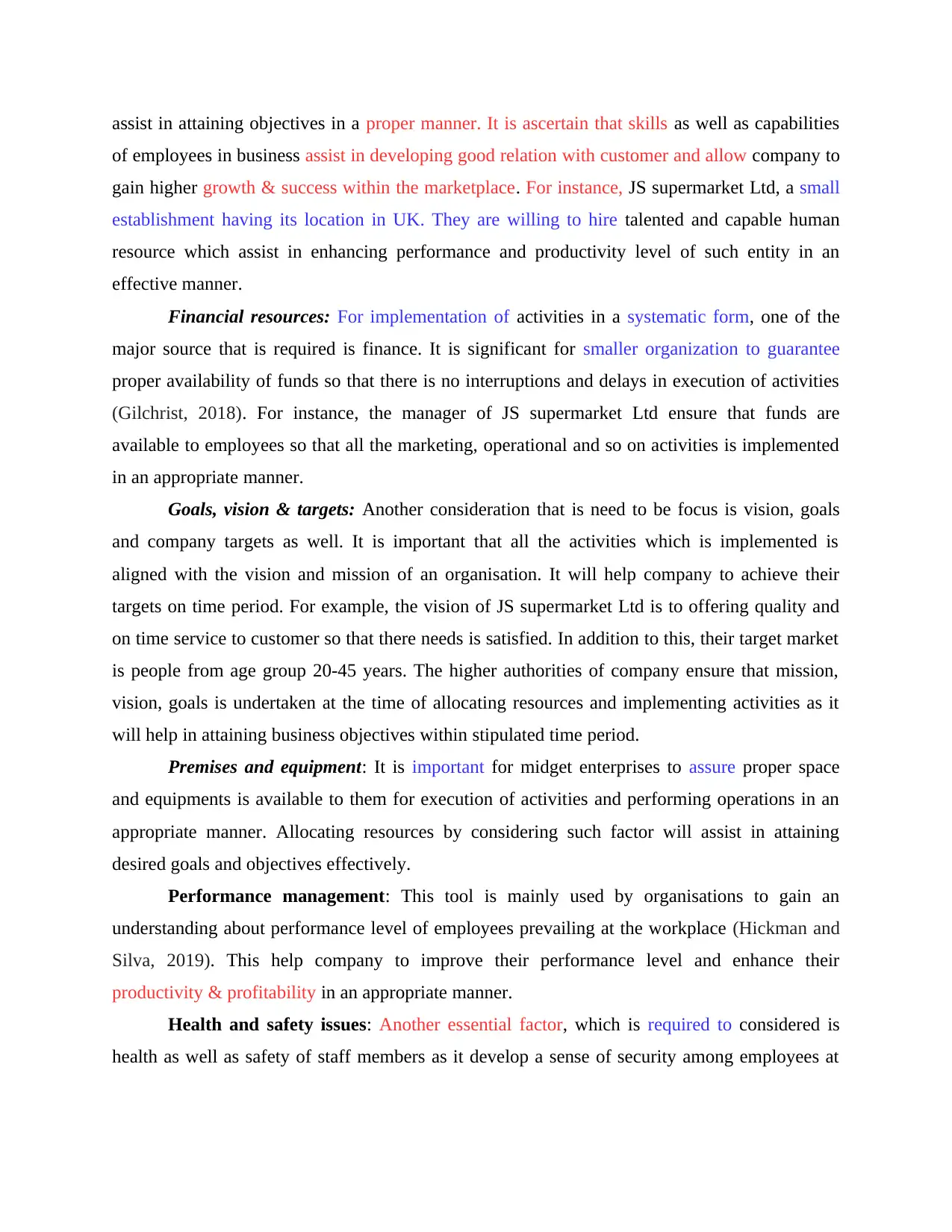
assist in attaining objectives in a proper manner. It is ascertain that skills as well as capabilities
of employees in business assist in developing good relation with customer and allow company to
gain higher growth & success within the marketplace. For instance, JS supermarket Ltd, a small
establishment having its location in UK. They are willing to hire talented and capable human
resource which assist in enhancing performance and productivity level of such entity in an
effective manner.
Financial resources: For implementation of activities in a systematic form, one of the
major source that is required is finance. It is significant for smaller organization to guarantee
proper availability of funds so that there is no interruptions and delays in execution of activities
(Gilchrist, 2018). For instance, the manager of JS supermarket Ltd ensure that funds are
available to employees so that all the marketing, operational and so on activities is implemented
in an appropriate manner.
Goals, vision & targets: Another consideration that is need to be focus is vision, goals
and company targets as well. It is important that all the activities which is implemented is
aligned with the vision and mission of an organisation. It will help company to achieve their
targets on time period. For example, the vision of JS supermarket Ltd is to offering quality and
on time service to customer so that there needs is satisfied. In addition to this, their target market
is people from age group 20-45 years. The higher authorities of company ensure that mission,
vision, goals is undertaken at the time of allocating resources and implementing activities as it
will help in attaining business objectives within stipulated time period.
Premises and equipment: It is important for midget enterprises to assure proper space
and equipments is available to them for execution of activities and performing operations in an
appropriate manner. Allocating resources by considering such factor will assist in attaining
desired goals and objectives effectively.
Performance management: This tool is mainly used by organisations to gain an
understanding about performance level of employees prevailing at the workplace (Hickman and
Silva, 2019). This help company to improve their performance level and enhance their
productivity & profitability in an appropriate manner.
Health and safety issues: Another essential factor, which is required to considered is
health as well as safety of staff members as it develop a sense of security among employees at
of employees in business assist in developing good relation with customer and allow company to
gain higher growth & success within the marketplace. For instance, JS supermarket Ltd, a small
establishment having its location in UK. They are willing to hire talented and capable human
resource which assist in enhancing performance and productivity level of such entity in an
effective manner.
Financial resources: For implementation of activities in a systematic form, one of the
major source that is required is finance. It is significant for smaller organization to guarantee
proper availability of funds so that there is no interruptions and delays in execution of activities
(Gilchrist, 2018). For instance, the manager of JS supermarket Ltd ensure that funds are
available to employees so that all the marketing, operational and so on activities is implemented
in an appropriate manner.
Goals, vision & targets: Another consideration that is need to be focus is vision, goals
and company targets as well. It is important that all the activities which is implemented is
aligned with the vision and mission of an organisation. It will help company to achieve their
targets on time period. For example, the vision of JS supermarket Ltd is to offering quality and
on time service to customer so that there needs is satisfied. In addition to this, their target market
is people from age group 20-45 years. The higher authorities of company ensure that mission,
vision, goals is undertaken at the time of allocating resources and implementing activities as it
will help in attaining business objectives within stipulated time period.
Premises and equipment: It is important for midget enterprises to assure proper space
and equipments is available to them for execution of activities and performing operations in an
appropriate manner. Allocating resources by considering such factor will assist in attaining
desired goals and objectives effectively.
Performance management: This tool is mainly used by organisations to gain an
understanding about performance level of employees prevailing at the workplace (Hickman and
Silva, 2019). This help company to improve their performance level and enhance their
productivity & profitability in an appropriate manner.
Health and safety issues: Another essential factor, which is required to considered is
health as well as safety of staff members as it develop a sense of security among employees at
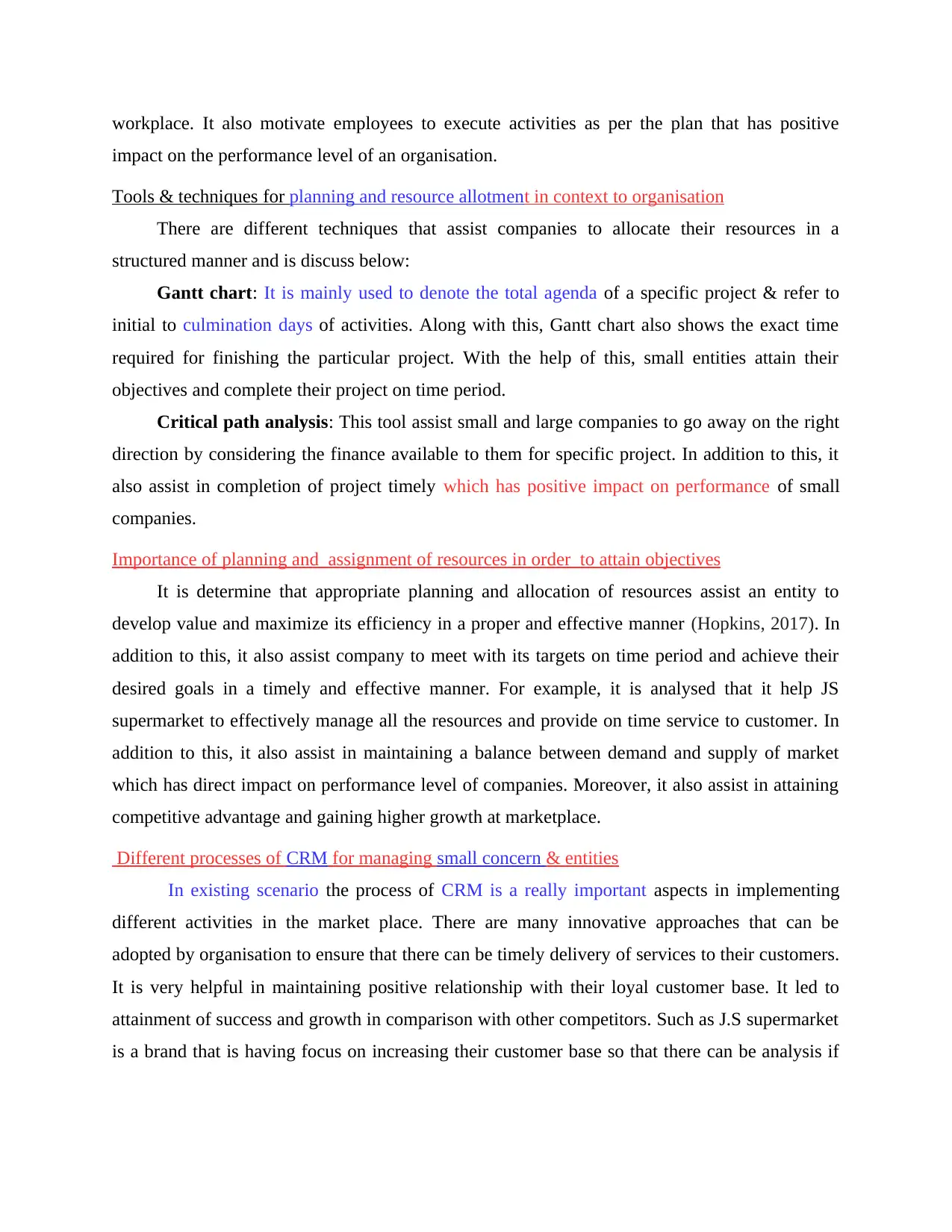
workplace. It also motivate employees to execute activities as per the plan that has positive
impact on the performance level of an organisation.
Tools & techniques for planning and resource allotment in context to organisation
There are different techniques that assist companies to allocate their resources in a
structured manner and is discuss below:
Gantt chart: It is mainly used to denote the total agenda of a specific project & refer to
initial to culmination days of activities. Along with this, Gantt chart also shows the exact time
required for finishing the particular project. With the help of this, small entities attain their
objectives and complete their project on time period.
Critical path analysis: This tool assist small and large companies to go away on the right
direction by considering the finance available to them for specific project. In addition to this, it
also assist in completion of project timely which has positive impact on performance of small
companies.
Importance of planning and assignment of resources in order to attain objectives
It is determine that appropriate planning and allocation of resources assist an entity to
develop value and maximize its efficiency in a proper and effective manner (Hopkins, 2017). In
addition to this, it also assist company to meet with its targets on time period and achieve their
desired goals in a timely and effective manner. For example, it is analysed that it help JS
supermarket to effectively manage all the resources and provide on time service to customer. In
addition to this, it also assist in maintaining a balance between demand and supply of market
which has direct impact on performance level of companies. Moreover, it also assist in attaining
competitive advantage and gaining higher growth at marketplace.
Different processes of CRM for managing small concern & entities
In existing scenario the process of CRM is a really important aspects in implementing
different activities in the market place. There are many innovative approaches that can be
adopted by organisation to ensure that there can be timely delivery of services to their customers.
It is very helpful in maintaining positive relationship with their loyal customer base. It led to
attainment of success and growth in comparison with other competitors. Such as J.S supermarket
is a brand that is having focus on increasing their customer base so that there can be analysis if
impact on the performance level of an organisation.
Tools & techniques for planning and resource allotment in context to organisation
There are different techniques that assist companies to allocate their resources in a
structured manner and is discuss below:
Gantt chart: It is mainly used to denote the total agenda of a specific project & refer to
initial to culmination days of activities. Along with this, Gantt chart also shows the exact time
required for finishing the particular project. With the help of this, small entities attain their
objectives and complete their project on time period.
Critical path analysis: This tool assist small and large companies to go away on the right
direction by considering the finance available to them for specific project. In addition to this, it
also assist in completion of project timely which has positive impact on performance of small
companies.
Importance of planning and assignment of resources in order to attain objectives
It is determine that appropriate planning and allocation of resources assist an entity to
develop value and maximize its efficiency in a proper and effective manner (Hopkins, 2017). In
addition to this, it also assist company to meet with its targets on time period and achieve their
desired goals in a timely and effective manner. For example, it is analysed that it help JS
supermarket to effectively manage all the resources and provide on time service to customer. In
addition to this, it also assist in maintaining a balance between demand and supply of market
which has direct impact on performance level of companies. Moreover, it also assist in attaining
competitive advantage and gaining higher growth at marketplace.
Different processes of CRM for managing small concern & entities
In existing scenario the process of CRM is a really important aspects in implementing
different activities in the market place. There are many innovative approaches that can be
adopted by organisation to ensure that there can be timely delivery of services to their customers.
It is very helpful in maintaining positive relationship with their loyal customer base. It led to
attainment of success and growth in comparison with other competitors. Such as J.S supermarket
is a brand that is having focus on increasing their customer base so that there can be analysis if
⊘ This is a preview!⊘
Do you want full access?
Subscribe today to unlock all pages.

Trusted by 1+ million students worldwide
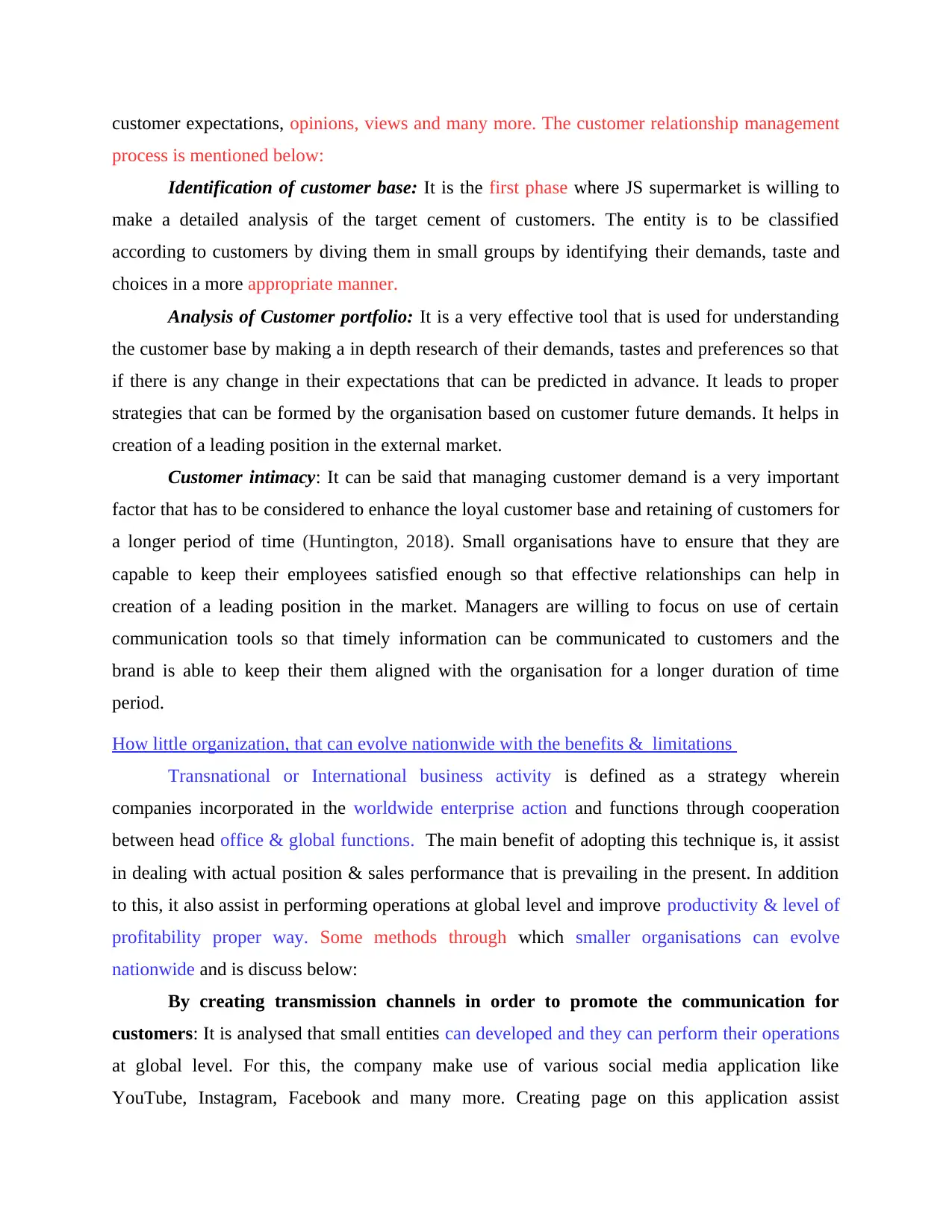
customer expectations, opinions, views and many more. The customer relationship management
process is mentioned below:
Identification of customer base: It is the first phase where JS supermarket is willing to
make a detailed analysis of the target cement of customers. The entity is to be classified
according to customers by diving them in small groups by identifying their demands, taste and
choices in a more appropriate manner.
Analysis of Customer portfolio: It is a very effective tool that is used for understanding
the customer base by making a in depth research of their demands, tastes and preferences so that
if there is any change in their expectations that can be predicted in advance. It leads to proper
strategies that can be formed by the organisation based on customer future demands. It helps in
creation of a leading position in the external market.
Customer intimacy: It can be said that managing customer demand is a very important
factor that has to be considered to enhance the loyal customer base and retaining of customers for
a longer period of time (Huntington, 2018). Small organisations have to ensure that they are
capable to keep their employees satisfied enough so that effective relationships can help in
creation of a leading position in the market. Managers are willing to focus on use of certain
communication tools so that timely information can be communicated to customers and the
brand is able to keep their them aligned with the organisation for a longer duration of time
period.
How little organization, that can evolve nationwide with the benefits & limitations
Transnational or International business activity is defined as a strategy wherein
companies incorporated in the worldwide enterprise action and functions through cooperation
between head office & global functions. The main benefit of adopting this technique is, it assist
in dealing with actual position & sales performance that is prevailing in the present. In addition
to this, it also assist in performing operations at global level and improve productivity & level of
profitability proper way. Some methods through which smaller organisations can evolve
nationwide and is discuss below:
By creating transmission channels in order to promote the communication for
customers: It is analysed that small entities can developed and they can perform their operations
at global level. For this, the company make use of various social media application like
YouTube, Instagram, Facebook and many more. Creating page on this application assist
process is mentioned below:
Identification of customer base: It is the first phase where JS supermarket is willing to
make a detailed analysis of the target cement of customers. The entity is to be classified
according to customers by diving them in small groups by identifying their demands, taste and
choices in a more appropriate manner.
Analysis of Customer portfolio: It is a very effective tool that is used for understanding
the customer base by making a in depth research of their demands, tastes and preferences so that
if there is any change in their expectations that can be predicted in advance. It leads to proper
strategies that can be formed by the organisation based on customer future demands. It helps in
creation of a leading position in the external market.
Customer intimacy: It can be said that managing customer demand is a very important
factor that has to be considered to enhance the loyal customer base and retaining of customers for
a longer period of time (Huntington, 2018). Small organisations have to ensure that they are
capable to keep their employees satisfied enough so that effective relationships can help in
creation of a leading position in the market. Managers are willing to focus on use of certain
communication tools so that timely information can be communicated to customers and the
brand is able to keep their them aligned with the organisation for a longer duration of time
period.
How little organization, that can evolve nationwide with the benefits & limitations
Transnational or International business activity is defined as a strategy wherein
companies incorporated in the worldwide enterprise action and functions through cooperation
between head office & global functions. The main benefit of adopting this technique is, it assist
in dealing with actual position & sales performance that is prevailing in the present. In addition
to this, it also assist in performing operations at global level and improve productivity & level of
profitability proper way. Some methods through which smaller organisations can evolve
nationwide and is discuss below:
By creating transmission channels in order to promote the communication for
customers: It is analysed that small entities can developed and they can perform their operations
at global level. For this, the company make use of various social media application like
YouTube, Instagram, Facebook and many more. Creating page on this application assist
Paraphrase This Document
Need a fresh take? Get an instant paraphrase of this document with our AI Paraphraser
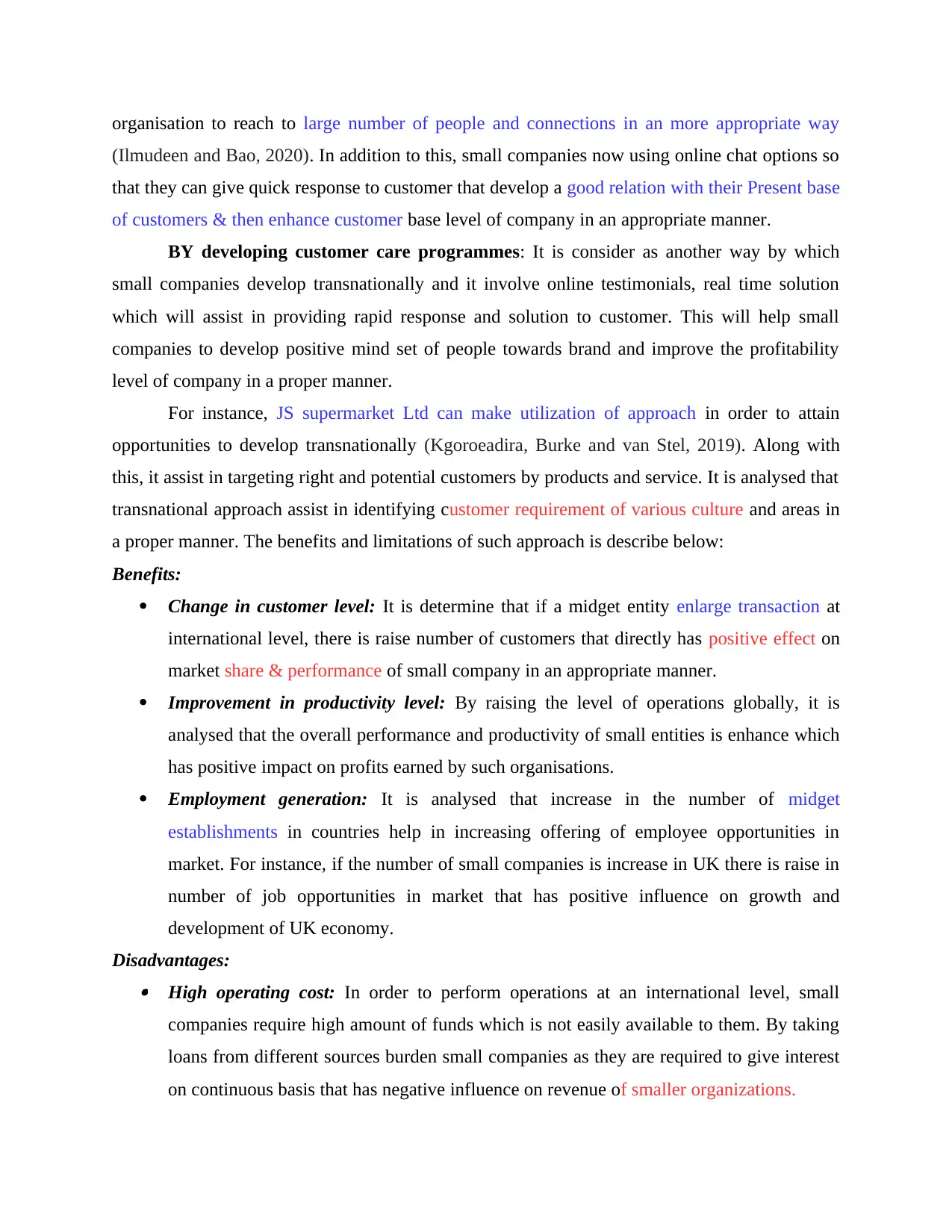
organisation to reach to large number of people and connections in an more appropriate way
(Ilmudeen and Bao, 2020). In addition to this, small companies now using online chat options so
that they can give quick response to customer that develop a good relation with their Present base
of customers & then enhance customer base level of company in an appropriate manner.
BY developing customer care programmes: It is consider as another way by which
small companies develop transnationally and it involve online testimonials, real time solution
which will assist in providing rapid response and solution to customer. This will help small
companies to develop positive mind set of people towards brand and improve the profitability
level of company in a proper manner.
For instance, JS supermarket Ltd can make utilization of approach in order to attain
opportunities to develop transnationally (Kgoroeadira, Burke and van Stel, 2019). Along with
this, it assist in targeting right and potential customers by products and service. It is analysed that
transnational approach assist in identifying customer requirement of various culture and areas in
a proper manner. The benefits and limitations of such approach is describe below:
Benefits:
Change in customer level: It is determine that if a midget entity enlarge transaction at
international level, there is raise number of customers that directly has positive effect on
market share & performance of small company in an appropriate manner.
Improvement in productivity level: By raising the level of operations globally, it is
analysed that the overall performance and productivity of small entities is enhance which
has positive impact on profits earned by such organisations.
Employment generation: It is analysed that increase in the number of midget
establishments in countries help in increasing offering of employee opportunities in
market. For instance, if the number of small companies is increase in UK there is raise in
number of job opportunities in market that has positive influence on growth and
development of UK economy.
Disadvantages: High operating cost: In order to perform operations at an international level, small
companies require high amount of funds which is not easily available to them. By taking
loans from different sources burden small companies as they are required to give interest
on continuous basis that has negative influence on revenue of smaller organizations.
(Ilmudeen and Bao, 2020). In addition to this, small companies now using online chat options so
that they can give quick response to customer that develop a good relation with their Present base
of customers & then enhance customer base level of company in an appropriate manner.
BY developing customer care programmes: It is consider as another way by which
small companies develop transnationally and it involve online testimonials, real time solution
which will assist in providing rapid response and solution to customer. This will help small
companies to develop positive mind set of people towards brand and improve the profitability
level of company in a proper manner.
For instance, JS supermarket Ltd can make utilization of approach in order to attain
opportunities to develop transnationally (Kgoroeadira, Burke and van Stel, 2019). Along with
this, it assist in targeting right and potential customers by products and service. It is analysed that
transnational approach assist in identifying customer requirement of various culture and areas in
a proper manner. The benefits and limitations of such approach is describe below:
Benefits:
Change in customer level: It is determine that if a midget entity enlarge transaction at
international level, there is raise number of customers that directly has positive effect on
market share & performance of small company in an appropriate manner.
Improvement in productivity level: By raising the level of operations globally, it is
analysed that the overall performance and productivity of small entities is enhance which
has positive impact on profits earned by such organisations.
Employment generation: It is analysed that increase in the number of midget
establishments in countries help in increasing offering of employee opportunities in
market. For instance, if the number of small companies is increase in UK there is raise in
number of job opportunities in market that has positive influence on growth and
development of UK economy.
Disadvantages: High operating cost: In order to perform operations at an international level, small
companies require high amount of funds which is not easily available to them. By taking
loans from different sources burden small companies as they are required to give interest
on continuous basis that has negative influence on revenue of smaller organizations.
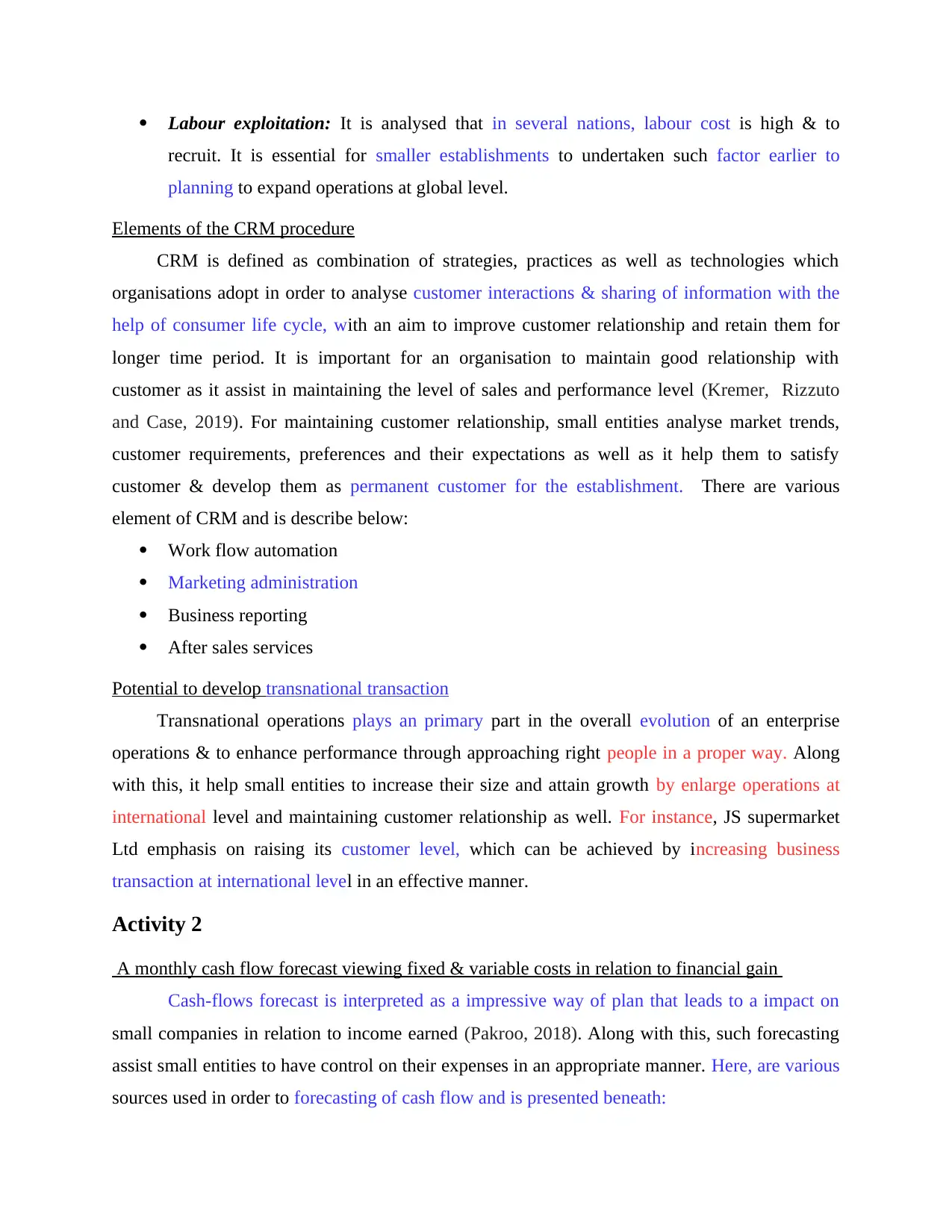
Labour exploitation: It is analysed that in several nations, labour cost is high & to
recruit. It is essential for smaller establishments to undertaken such factor earlier to
planning to expand operations at global level.
Elements of the CRM procedure
CRM is defined as combination of strategies, practices as well as technologies which
organisations adopt in order to analyse customer interactions & sharing of information with the
help of consumer life cycle, with an aim to improve customer relationship and retain them for
longer time period. It is important for an organisation to maintain good relationship with
customer as it assist in maintaining the level of sales and performance level (Kremer, Rizzuto
and Case, 2019). For maintaining customer relationship, small entities analyse market trends,
customer requirements, preferences and their expectations as well as it help them to satisfy
customer & develop them as permanent customer for the establishment. There are various
element of CRM and is describe below:
Work flow automation
Marketing administration
Business reporting
After sales services
Potential to develop transnational transaction
Transnational operations plays an primary part in the overall evolution of an enterprise
operations & to enhance performance through approaching right people in a proper way. Along
with this, it help small entities to increase their size and attain growth by enlarge operations at
international level and maintaining customer relationship as well. For instance, JS supermarket
Ltd emphasis on raising its customer level, which can be achieved by increasing business
transaction at international level in an effective manner.
Activity 2
A monthly cash flow forecast viewing fixed & variable costs in relation to financial gain
Cash-flows forecast is interpreted as a impressive way of plan that leads to a impact on
small companies in relation to income earned (Pakroo, 2018). Along with this, such forecasting
assist small entities to have control on their expenses in an appropriate manner. Here, are various
sources used in order to forecasting of cash flow and is presented beneath:
recruit. It is essential for smaller establishments to undertaken such factor earlier to
planning to expand operations at global level.
Elements of the CRM procedure
CRM is defined as combination of strategies, practices as well as technologies which
organisations adopt in order to analyse customer interactions & sharing of information with the
help of consumer life cycle, with an aim to improve customer relationship and retain them for
longer time period. It is important for an organisation to maintain good relationship with
customer as it assist in maintaining the level of sales and performance level (Kremer, Rizzuto
and Case, 2019). For maintaining customer relationship, small entities analyse market trends,
customer requirements, preferences and their expectations as well as it help them to satisfy
customer & develop them as permanent customer for the establishment. There are various
element of CRM and is describe below:
Work flow automation
Marketing administration
Business reporting
After sales services
Potential to develop transnational transaction
Transnational operations plays an primary part in the overall evolution of an enterprise
operations & to enhance performance through approaching right people in a proper way. Along
with this, it help small entities to increase their size and attain growth by enlarge operations at
international level and maintaining customer relationship as well. For instance, JS supermarket
Ltd emphasis on raising its customer level, which can be achieved by increasing business
transaction at international level in an effective manner.
Activity 2
A monthly cash flow forecast viewing fixed & variable costs in relation to financial gain
Cash-flows forecast is interpreted as a impressive way of plan that leads to a impact on
small companies in relation to income earned (Pakroo, 2018). Along with this, such forecasting
assist small entities to have control on their expenses in an appropriate manner. Here, are various
sources used in order to forecasting of cash flow and is presented beneath:
⊘ This is a preview!⊘
Do you want full access?
Subscribe today to unlock all pages.

Trusted by 1+ million students worldwide
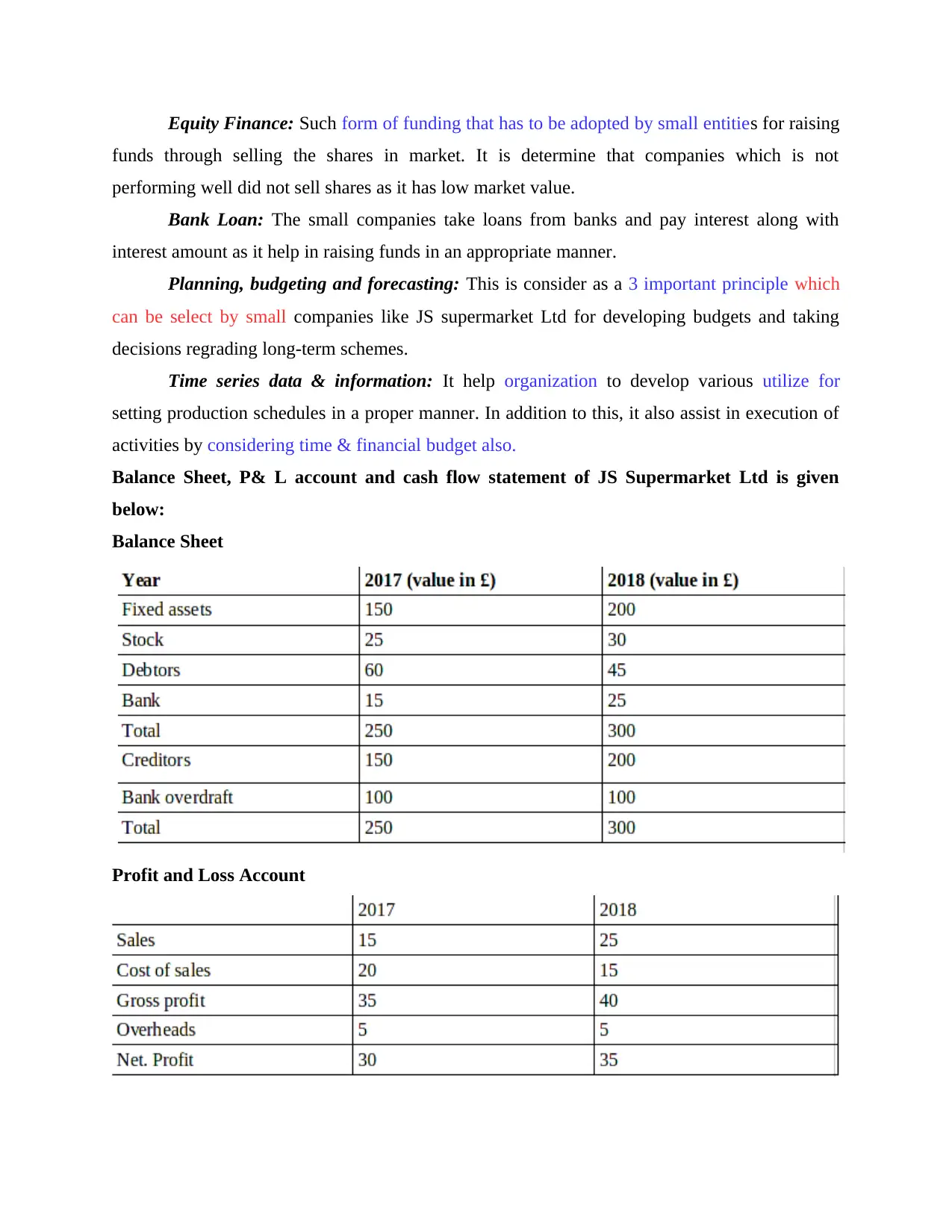
Equity Finance: Such form of funding that has to be adopted by small entities for raising
funds through selling the shares in market. It is determine that companies which is not
performing well did not sell shares as it has low market value.
Bank Loan: The small companies take loans from banks and pay interest along with
interest amount as it help in raising funds in an appropriate manner.
Planning, budgeting and forecasting: This is consider as a 3 important principle which
can be select by small companies like JS supermarket Ltd for developing budgets and taking
decisions regrading long-term schemes.
Time series data & information: It help organization to develop various utilize for
setting production schedules in a proper manner. In addition to this, it also assist in execution of
activities by considering time & financial budget also.
Balance Sheet, P& L account and cash flow statement of JS Supermarket Ltd is given
below:
Balance Sheet
Profit and Loss Account
funds through selling the shares in market. It is determine that companies which is not
performing well did not sell shares as it has low market value.
Bank Loan: The small companies take loans from banks and pay interest along with
interest amount as it help in raising funds in an appropriate manner.
Planning, budgeting and forecasting: This is consider as a 3 important principle which
can be select by small companies like JS supermarket Ltd for developing budgets and taking
decisions regrading long-term schemes.
Time series data & information: It help organization to develop various utilize for
setting production schedules in a proper manner. In addition to this, it also assist in execution of
activities by considering time & financial budget also.
Balance Sheet, P& L account and cash flow statement of JS Supermarket Ltd is given
below:
Balance Sheet
Profit and Loss Account
Paraphrase This Document
Need a fresh take? Get an instant paraphrase of this document with our AI Paraphraser
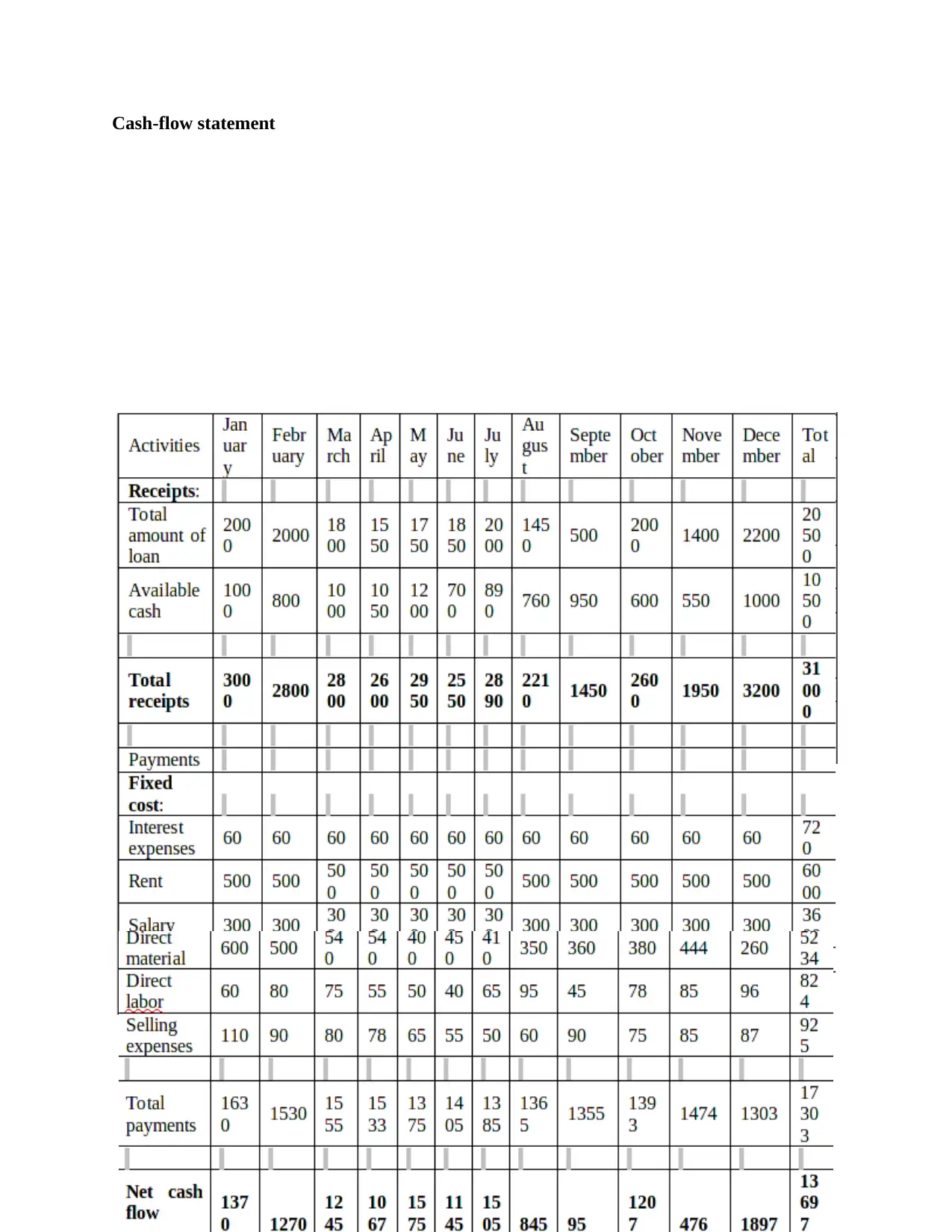
Cash-flow statement
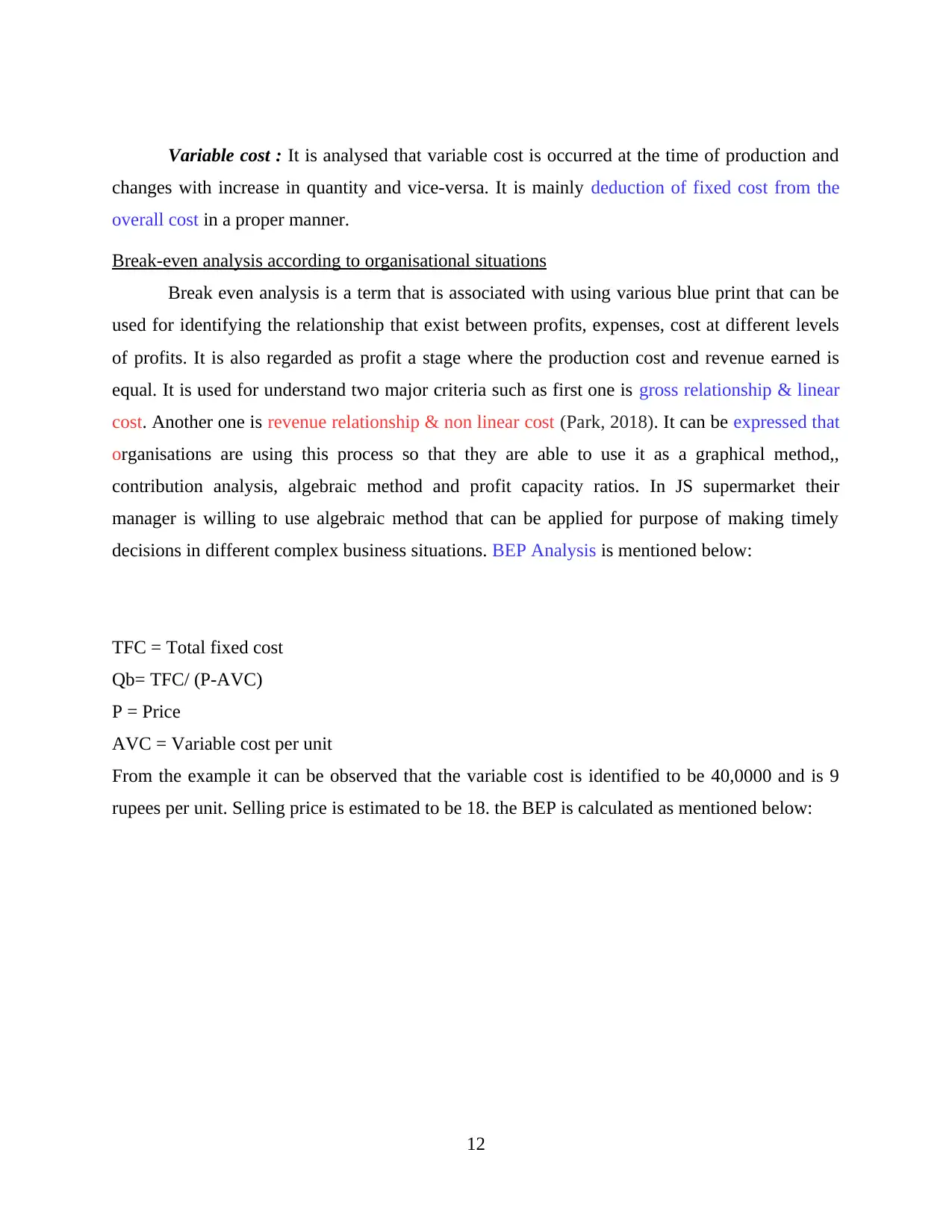
Variable cost : It is analysed that variable cost is occurred at the time of production and
changes with increase in quantity and vice-versa. It is mainly deduction of fixed cost from the
overall cost in a proper manner.
Break-even analysis according to organisational situations
Break even analysis is a term that is associated with using various blue print that can be
used for identifying the relationship that exist between profits, expenses, cost at different levels
of profits. It is also regarded as profit a stage where the production cost and revenue earned is
equal. It is used for understand two major criteria such as first one is gross relationship & linear
cost. Another one is revenue relationship & non linear cost (Park, 2018). It can be expressed that
organisations are using this process so that they are able to use it as a graphical method,,
contribution analysis, algebraic method and profit capacity ratios. In JS supermarket their
manager is willing to use algebraic method that can be applied for purpose of making timely
decisions in different complex business situations. BEP Analysis is mentioned below:
TFC = Total fixed cost
Qb= TFC/ (P-AVC)
P = Price
AVC = Variable cost per unit
From the example it can be observed that the variable cost is identified to be 40,0000 and is 9
rupees per unit. Selling price is estimated to be 18. the BEP is calculated as mentioned below:
12
changes with increase in quantity and vice-versa. It is mainly deduction of fixed cost from the
overall cost in a proper manner.
Break-even analysis according to organisational situations
Break even analysis is a term that is associated with using various blue print that can be
used for identifying the relationship that exist between profits, expenses, cost at different levels
of profits. It is also regarded as profit a stage where the production cost and revenue earned is
equal. It is used for understand two major criteria such as first one is gross relationship & linear
cost. Another one is revenue relationship & non linear cost (Park, 2018). It can be expressed that
organisations are using this process so that they are able to use it as a graphical method,,
contribution analysis, algebraic method and profit capacity ratios. In JS supermarket their
manager is willing to use algebraic method that can be applied for purpose of making timely
decisions in different complex business situations. BEP Analysis is mentioned below:
TFC = Total fixed cost
Qb= TFC/ (P-AVC)
P = Price
AVC = Variable cost per unit
From the example it can be observed that the variable cost is identified to be 40,0000 and is 9
rupees per unit. Selling price is estimated to be 18. the BEP is calculated as mentioned below:
12
⊘ This is a preview!⊘
Do you want full access?
Subscribe today to unlock all pages.

Trusted by 1+ million students worldwide
1 out of 21
Related Documents
Your All-in-One AI-Powered Toolkit for Academic Success.
+13062052269
info@desklib.com
Available 24*7 on WhatsApp / Email
![[object Object]](/_next/static/media/star-bottom.7253800d.svg)
Unlock your academic potential
Copyright © 2020–2025 A2Z Services. All Rights Reserved. Developed and managed by ZUCOL.




